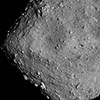 In October 2018, Space Shuttle Hayabusa2 dropped the Asteroid Surface Landing Gear (MASCOT) on the surface of the asteroid Ryugu (162173). Jaumann et al. analyzed the images taken by the camera MASCOT and allowed to reconstrZuct the trajectory of descent and rebound of the landing gear of 10kg on the asteroid. The analysis is the subject of a publication in Sciences, published on 23 August 2019 and co-written by Patrick Michel of the Lagrange Laboratory of the Côte d'Azur Observatory (CNRS / OCA / UNS).
In October 2018, Space Shuttle Hayabusa2 dropped the Asteroid Surface Landing Gear (MASCOT) on the surface of the asteroid Ryugu (162173). Jaumann et al. analyzed the images taken by the camera MASCOT and allowed to reconstrZuct the trajectory of descent and rebound of the landing gear of 10kg on the asteroid. The analysis is the subject of a publication in Sciences, published on 23 August 2019 and co-written by Patrick Michel of the Lagrange Laboratory of the Côte d'Azur Observatory (CNRS / OCA / UNS).
MASCOT was released from the mother ship Hayabusa2 on 3 October 2018 at an elevation of 41 m above the surface of Ryugu. During his first contact with the surface MASCOT then bounced back and traveled an additional 17m to reach his first resting point in a local depression. During the 6-minute descent to the surface and rebound phase, the MASCam instrument took 20 images. During the same period, the Hayabusa2 optical navigation camera recorded the MASCOT shadow on the surface and the undercarriage itself when its bright white top was visible.
These images show us the surface of Ryugu as covered with rocks ranging from decimetre to meter, without deposits of fine materials. These rocks were either bright, with smooth faces and sharp edges, or dark, with a friable surface and resembling a cauliflower. The close-up images of a last image are a dark matrix with small luminous and spectrally different inclusions, which has not been modified.
-
Inclusions appear similar to those of carbonaceous chondrite meteorites
Colorful light-emitting diodes were used to illuminate the night artist's surroundings and produce color images. The surface of Ryugu is not of a dust of fine. The inclusions of the size of a millimeter in the rocks are similar to those of the carbonaceous carbonite meteorite. MASCOT pendant worked 17 hours on the surface before its non-rechargeable batteries are depleted. Colored LEDs were used to illuminate the surroundings of the LG at night and produce color images. The Ryugu surface is dominated by two types of rocks, but there is no evidence of fine dust. The one-millimeter inclusions in rocks are similar to those found in carbon-chondrite meteorites. MASCOT worked for 17 hours on the surface before its non-rechargeable batteries ran out.
Photograph of the surface of (162173) Ryugu, taken at night by the MASCOT camera
PHOTO: MASCOT/DLR/JAXA
----------------------------Authors :
R. Jaumann1,2*, N. Schmitz1, T.-M. Ho3, S. E. Schröder1, K. A. Otto1, K. Stephan1, S. Elgner1, K. Krohn1, F. Preusker1, F. Scholten1, J. Biele4, S. Ulamec4, C. Krause4, S. Sugita5, K.-D. Matz1, T. Roatsch1, R. Parekh1,2, S. Mottola1, M. Grott1, P. Michel6, F. Trauthan1, A. Koncz1, H. Michaelis1, C. Lange3, J. T. Grundmann3, M. Maibaum4, K. Sasaki3, F. Wolff7, J. Reill8, A. Moussi-Soffys9, L. Lorda9, W. Neumann1, J.-B. Vincent1, R. Wagner1, J.-P. Bibring10, S. Kameda11, H. Yano12, S. Watanabe12,13, M. Yoshikawa12, Y. Tsuda12, T. Okada12, T. Yoshimitsu12, Y. Mimasu12, T. Saiki12, H. Yabuta14, H. Rauer1,2, R. Honda15, T. Morota16, Y. Yokota12, T. Kouyama17
References
Jaumann et al.
Science 23 Aug 2019:
Vol. 365, Issue 6455, pp. 817-820
DOI: 10.1126/science.aaw8627Contacts
Patrick Michel : michelp@oca.eu - directeur de Recherches au CNRS, Responsable de l’Équipe TOP (Théories et Observations en Planétologie), Laboratoire Lagrange/CNRS, Observatoire de la Côte d’Azur
Guy Libourel : guy.libourel@oca.eu - chercheur au CNRS - Laboratoire Lagrange/CNRS - Observatoire de la Côte d'Azur






